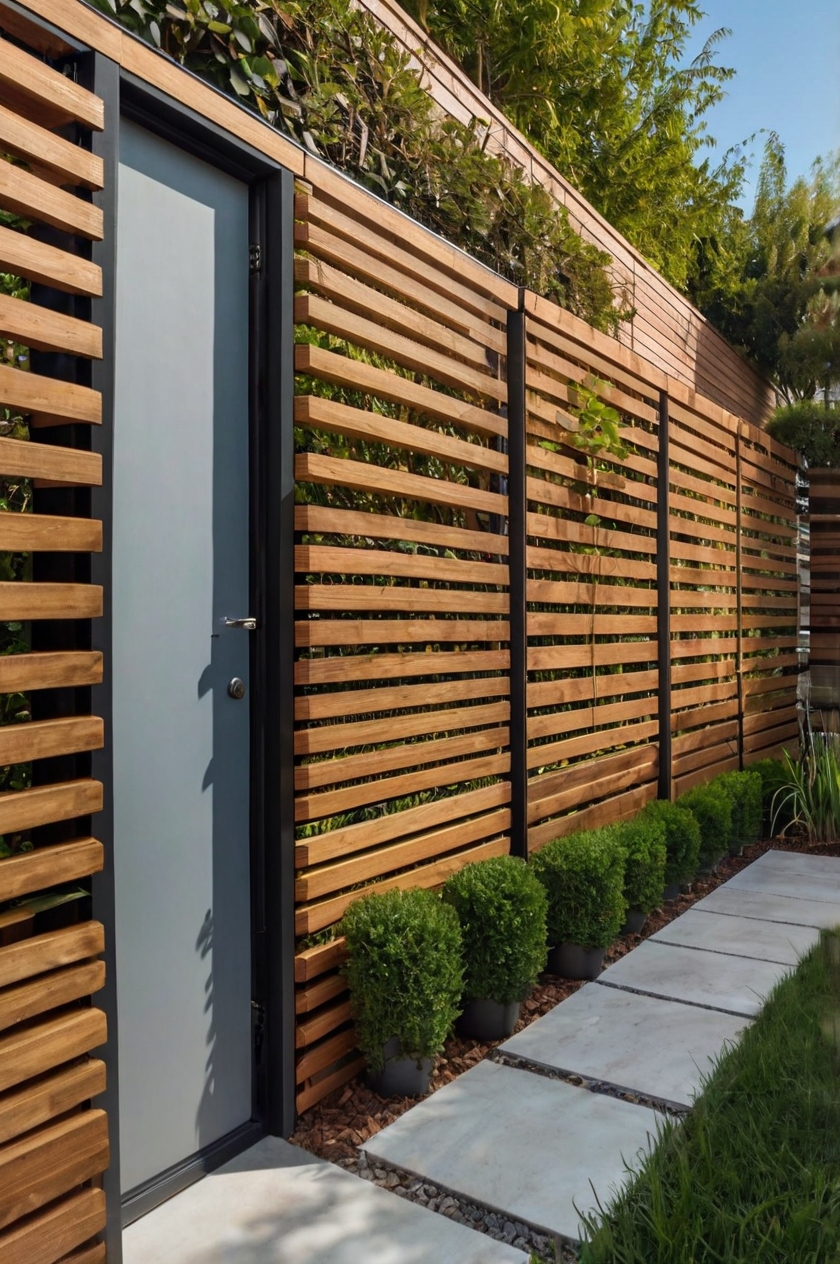When it was time to install my own privacy fence, I went down a rabbit hole of unique designs that would not only provide privacy but also make a statement.
The options I discovered blew my mind – and I’m here to share them with you.
No more boring picket fences or cookie-cutter vinyl panels!
✨Click to Get My 101 FREE Designer Room Ideas
Living Green Walls: Nature’s Privacy Shield

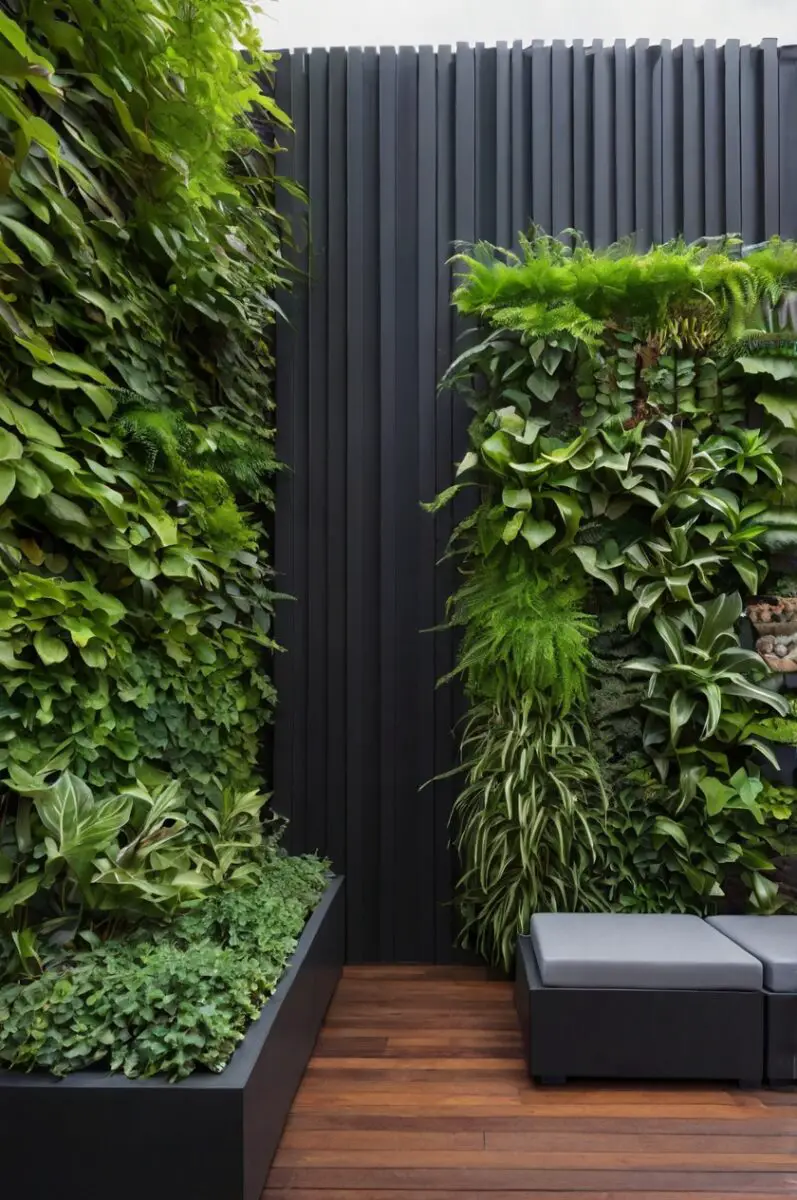
A living green wall isn’t just a fence – it’s an ecosystem right in your backyard.
These vertical gardens combine sturdy frameworks with pockets for soil and plants, creating a lush barrier between you and the outside world.
Imagine sipping your morning coffee surrounded by a wall of ferns, flowering vines, and fragrant herbs.
The best part?
These living fences change with the seasons, offering new colors and textures throughout the year.
You can choose drought-resistant succulents for low-maintenance options or flowering climbers for a more dramatic effect.
Consider installing a simple irrigation system to keep your living wall thriving without daily watering chores.
For instant impact, you can purchase pre-grown panels from specialty nurseries that arrive ready to install.
The structure itself can be as simple as cattle panels mounted between posts or as elaborate as custom-designed metal frameworks with built-in planters.
Privacy-wise, these green barriers can reach heights of 8 feet or more while creating a microclimate that helps cool your yard in summer.
Birds and beneficial insects will flock to your living fence, bringing your outdoor space to life.
You’ll need to factor in some maintenance time – trimming, replanting, and occasional fertilizing – but the results are worth every minute.
Cost-wise, living walls can be created on a budget with DIY approaches or scaled up with professional installation for a truly spectacular result.
Remember to check local regulations, as some areas have height restrictions for fences, though living walls sometimes fall into different categories than traditional fences.
Gabion Stone Walls: Industrial Chic Meets Natural Texture

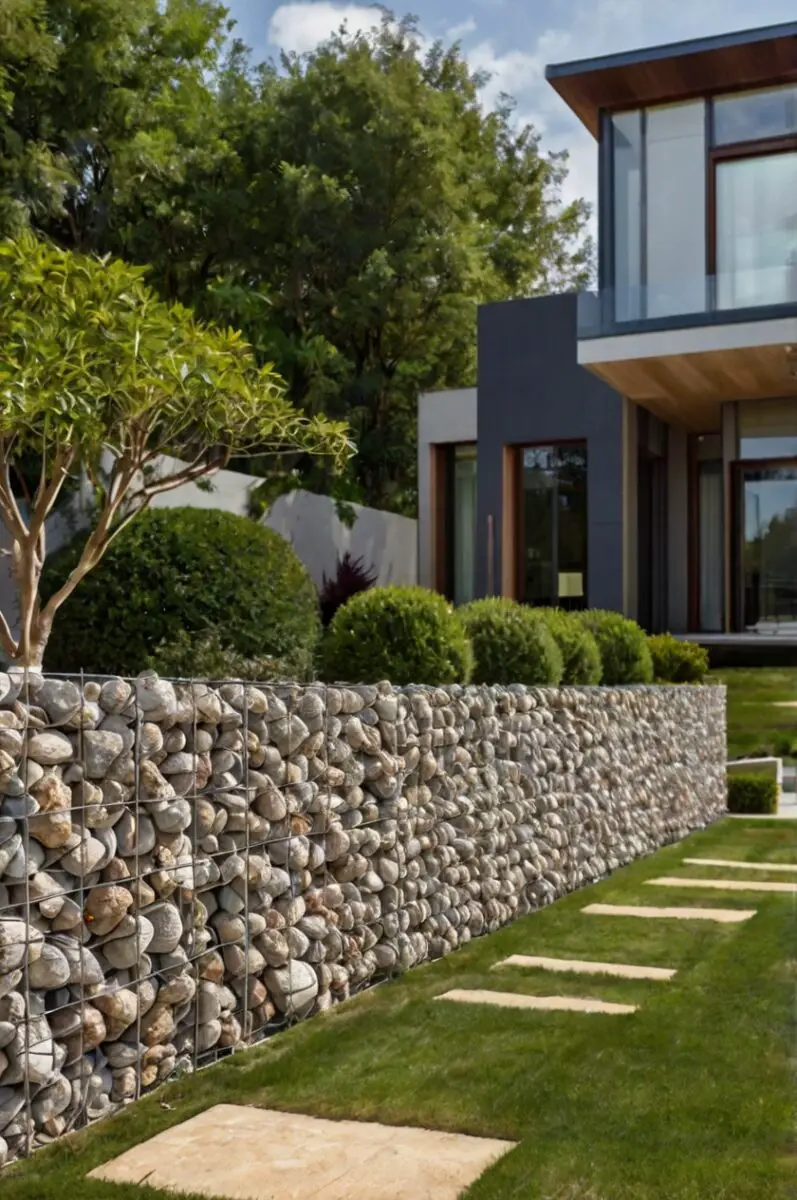
Gabion walls – those metal cages filled with stones – have jumped from commercial landscaping into residential spaces with stunning results.
These industrial-chic barriers offer incredible durability while creating a unique textural element in your landscape.
You can fill the metal cages with virtually any stone that catches your fancy, from rough-cut granite to smooth river rocks or even recycled glass chunks.
The see-through quality can be adjusted by your stone choice – smaller, densely packed stones create more privacy while larger rocks leave interesting gaps for light to filter through.
For complete privacy, consider backing your gabion wall with metal panels or growing vines through the stones.
Installation requires some heavy lifting but is surprisingly straightforward – metal cages are secured to posts, then filled with your chosen material.
The beauty of gabion walls is their adaptability to uneven terrain, making them perfect for sloped properties where traditional fencing becomes challenging.
These structures can last for decades with virtually no maintenance required – no painting, no staining, no replacing rotted boards.
You can incorporate lighting into your gabion fence by weaving waterproof LED strips between the stones for a magical nighttime effect.
For a truly custom look, create patterns with different colored stones or layer materials for an ombré effect from bottom to top.
Concerned about costs?
Gabion fences can actually be budget-friendly if you source local stone or use recycled materials like broken concrete pieces (urbanites).
The metal cages themselves are relatively inexpensive compared to high-end fencing materials and can be purchased in various sizes to suit your needs.
You might consider combining gabion sections with other fencing styles for visual interest – perhaps alternating with wooden panels or living wall sections.
Horizontal Slat Fences: Modern Minimalism That Maximizes Style

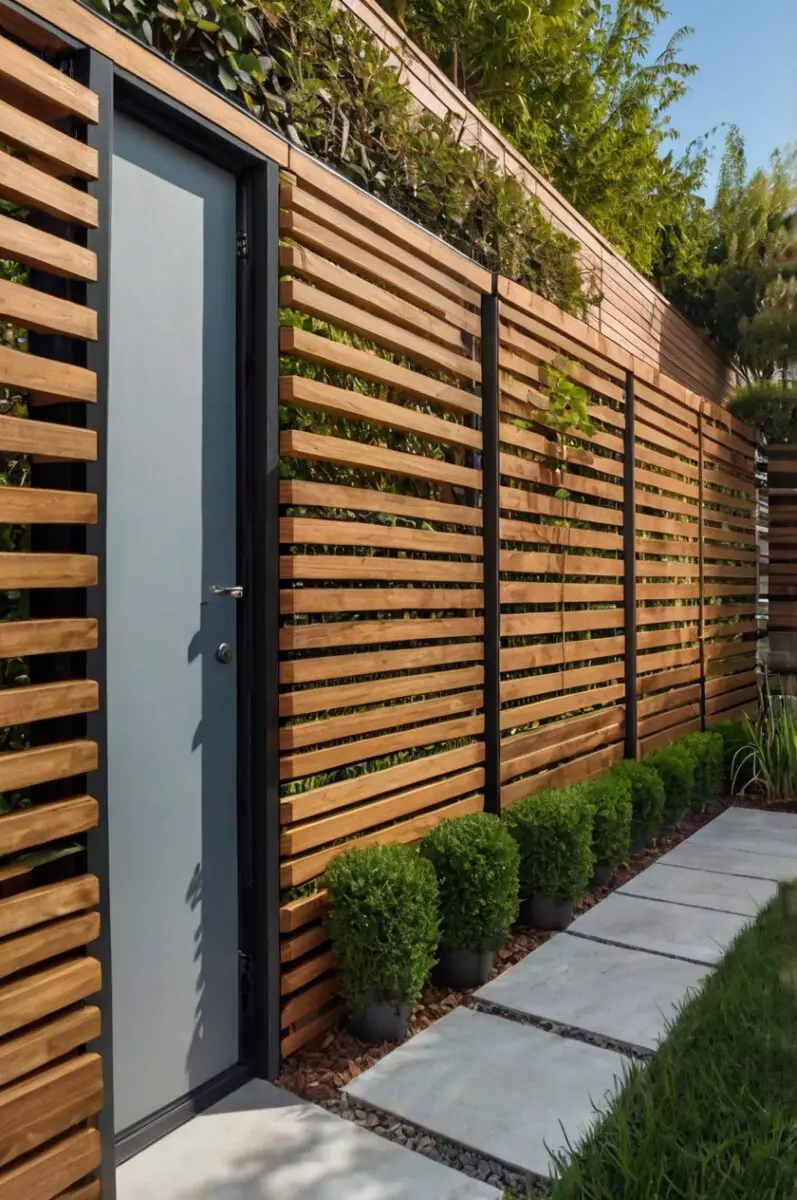
Horizontal slat fences have revolutionized the modern landscape with their clean lines and architectural presence.
Unlike traditional vertical pickets, these fences feature boards running parallel to the ground, creating an elongating effect that makes your property appear wider.
You can customize the spacing between slats – tight spacing for maximum privacy or wider gaps to allow breezes and filtered light.
These fences work beautifully with contemporary homes but can also provide an interesting contrast with more traditional architecture.
The wood you choose dramatically affects the final look – cedar offers warmth, ipe provides exotic luxury, while painted pine allows for bold color statements.
For a twist on the classic look, consider alternating slat widths or incorporating metal elements between wooden boards.
Installation requires precision to maintain those perfect horizontal lines, so proper planning and leveling are essential.
Many homeowners are now incorporating built-in seating, planters, or even outdoor kitchen elements into their horizontal slat fence designs.
You’ll find that these fences can be designed to appear to float above the ground, creating a lighter visual impact than fences that connect directly to the soil.
Lighting options abound with horizontal designs – strip lighting under certain slats creates a dramatic nighttime effect without visible fixtures.
Maintenance varies by material choice, with composite or vinyl options requiring virtually no upkeep while wood varieties need periodic sealing or staining.
The simple geometry of horizontal slats pairs beautifully with architectural plantings like ornamental grasses or structured shrubs.
You might consider a curved horizontal slat fence for a truly unique look – these can be custom-built to follow landscape contours or create deliberate sculptural forms.
Mixed Material Masterpieces: Breaking All the Rules
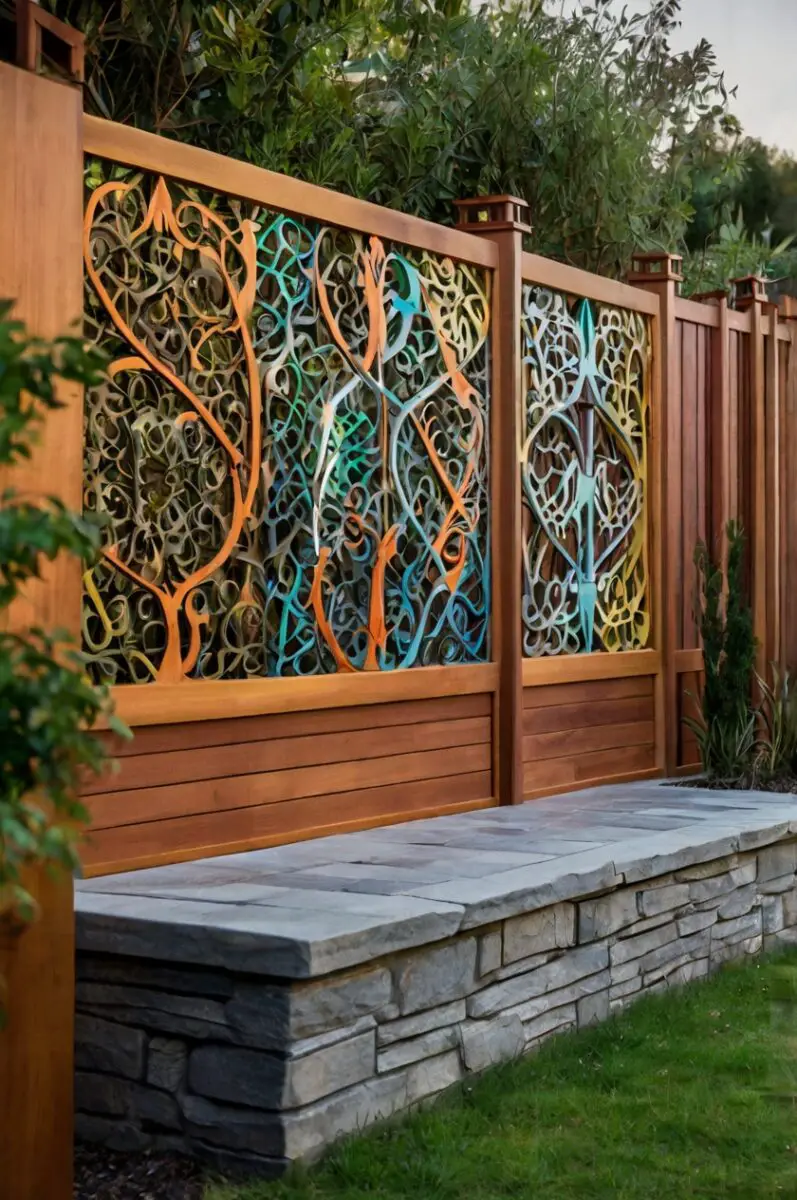
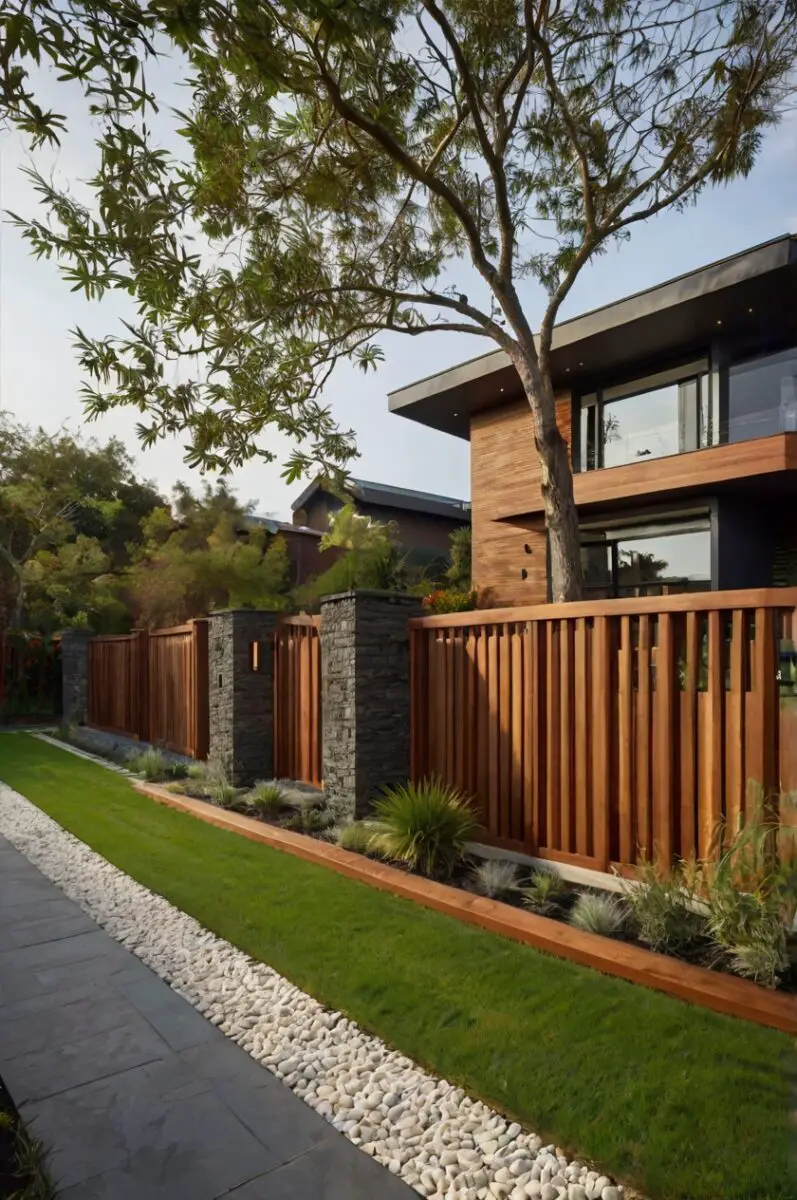
Mixed material fences throw out the rulebook by combining elements that traditionally wouldn’t share the same space.
Think weathered wood paired with corrugated metal, or gabion stone sections interrupted by panels of frosted glass.
You can express your personality through these combinations – industrial elements for an urban vibe or natural materials for an organic feel.
These fences become conversation pieces, blurring the line between functional barrier and outdoor art installation.
The contrast between textures – rough and smooth, natural and manufactured – creates visual interest that standard fences simply can’t match.
For practical purposes, you might use more expensive materials only where they’ll have the most impact, stretching your budget while maximizing style.
Consider how different materials age – some will weather and patina beautifully while others maintain their original appearance for years.
Height variations add another dimension to mixed material fences, creating rhythm and movement across your property line.
You’ll want to ensure that transitions between materials are thoughtfully designed with appropriate connectors and finishing details.
Weather resistance varies dramatically between materials, so plan your combinations with your local climate in mind.
These hybrid fences allow you to incorporate functional elements like built-in planters, water features, or even outdoor shower spaces.
The modular nature of mixed material designs means you can replace or update sections over time without redoing the entire fence.
You might find that certain material combinations create unexpected acoustic benefits, either amplifying pleasant sounds or dampening unwanted noise.
✨Click to Get My 101 FREE Designer Room Ideas
Japanese-Inspired Bamboo Screens: Zen Simplicity Meets Practical Privacy
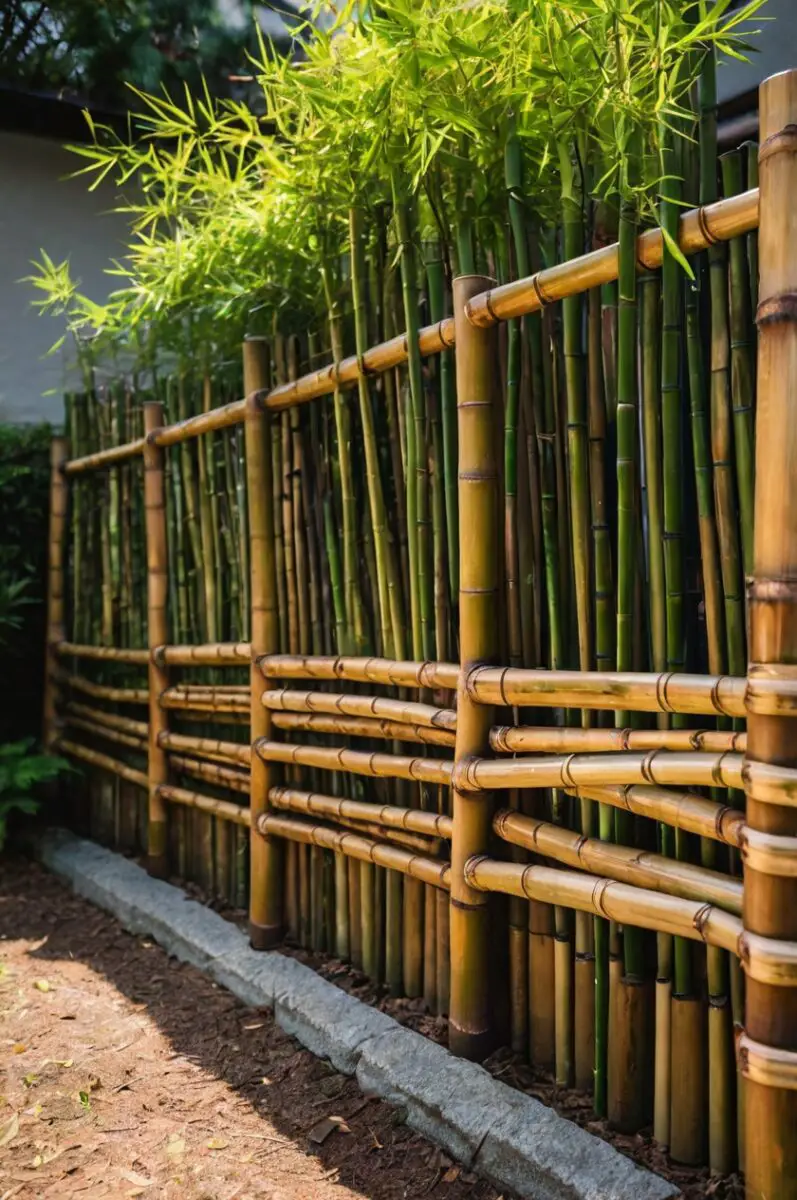
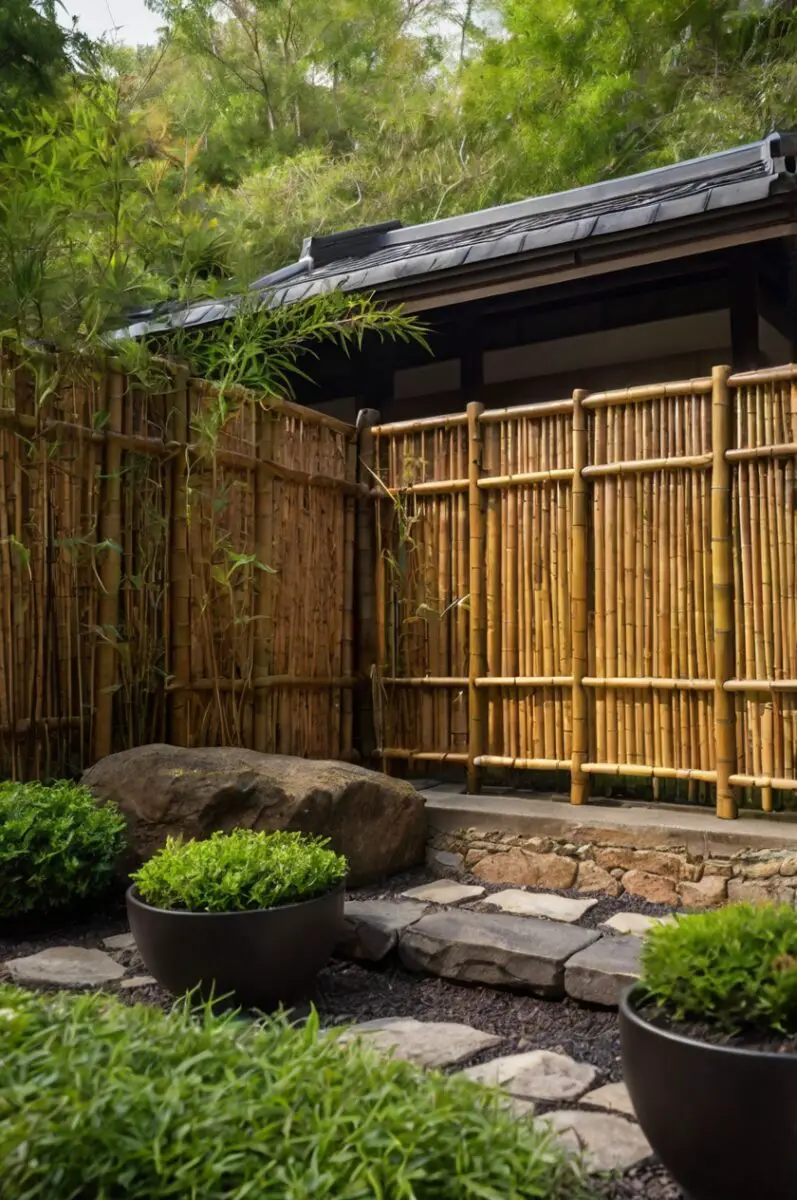
Japanese bamboo screens transform ordinary boundaries into serene retreats with their natural texture and filtered light effects.
Unlike the flimsy rolled bamboo from big box stores, authentic bamboo privacy screens use substantial poles secured in multiple layers for durability and visual depth.
You can choose from several bamboo varieties, from the golden tones of Phyllostachys aurea to the dramatic black stems of Black Bamboo.
These screens often incorporate elegant joinery systems using natural twine or hidden steel cables that enhance both aesthetics and structural integrity.
Traditional Japanese designs feature bamboo panels set into wooden frames, creating a rhythmic pattern across your property line.
For a contemporary twist, consider black-stained bamboo with steel frame elements or resin-coated poles for extended outdoor durability.
You’ll find that bamboo creates a distinctive sound when breeze passes through it – a gentle, natural music that adds another sensory dimension to your outdoor space.
Many bamboo fence designs incorporate moon gates or viewing windows that frame specific landscape elements while maintaining overall privacy.
The installation process for quality bamboo fencing requires specialized knowledge, as the material expands and contracts with weather changes.
You can enhance your bamboo screen with strategic lighting – uplight for dramatic shadow play or soft wash lighting to highlight the natural texture after dark.
For those concerned about sustainability, bamboo represents an eco-friendly choice as it’s one of the fastest-growing renewable resources on the planet.
Heights can vary dramatically with bamboo fencing, from low decorative borders to soaring 12-foot privacy screens that create true seclusion.
You might consider a bamboo and stone combination, with bamboo panels set between stone pillars for a harmonious blend of natural elements.
Artistic Metal Cutout Panels: Functional Sculpture for Your Perimeter
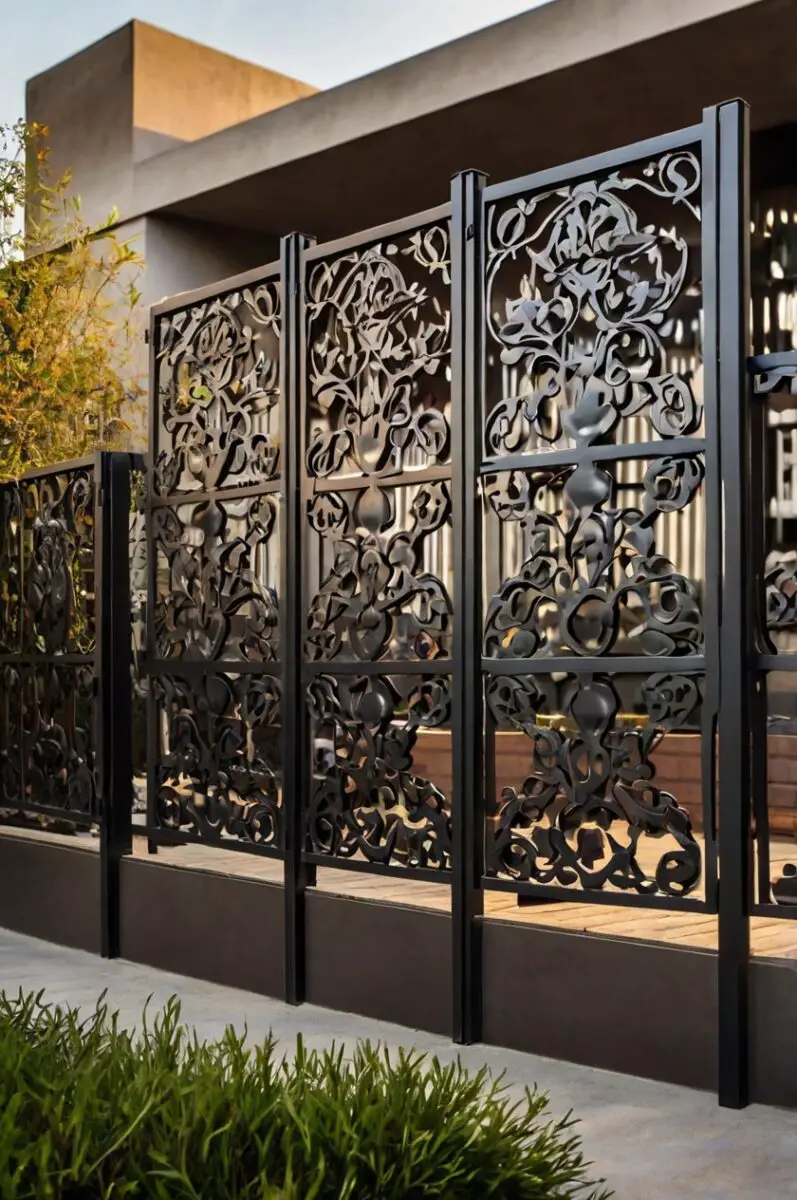
Metal cutout panels transform ordinary boundaries into gallery-worthy installations that filter light and views in mesmerizing patterns.
These architectural elements create ever-changing shadow plays as the sun moves across the sky, bringing your fence to life throughout the day.
You can choose from endless design possibilities – geometric patterns for modern spaces, nature-inspired motifs for organic environments, or completely custom designs that tell your personal story.
The metal choice impacts both aesthetics and longevity – Corten steel develops a warm rusty patina, aluminum remains lightweight and rust-free, while copper transforms to verdigris over time.
Privacy levels can be customized by varying the density of cutouts – more negative space for a lightweight screen or tighter patterns for increased seclusion.
These panels work beautifully as complete fence systems or as strategic inserts within more solid fencing where visual interest is desired.
You’ll find that backlit metal panels create spectacular nighttime displays, turning your boundary into an artistic light fixture.
Many homeowners are commissioning panels that incorporate family names, meaningful symbols, or references to their professional or personal passions.
Installation typically involves mounting panels to a sturdy frame system, with various options for posts and supporting structures.
The durability of metal cutout panels makes them ideal for harsh climates, though certain metals may require specific finishes for coastal areas.
You can combine these panels with plantings for a dynamic interaction – vines growing through openings or tall grasses that move behind the fixed patterns.
Cost varies widely based on complexity, material choice, and whether you’re purchasing pre-made designs or commissioning custom work.
These artistic barriers often become neighborhood landmarks, setting your property apart while adding to the overall aesthetic of your community.
Reclaimed Wood Wonders: Sustainable Stories in Every Slat
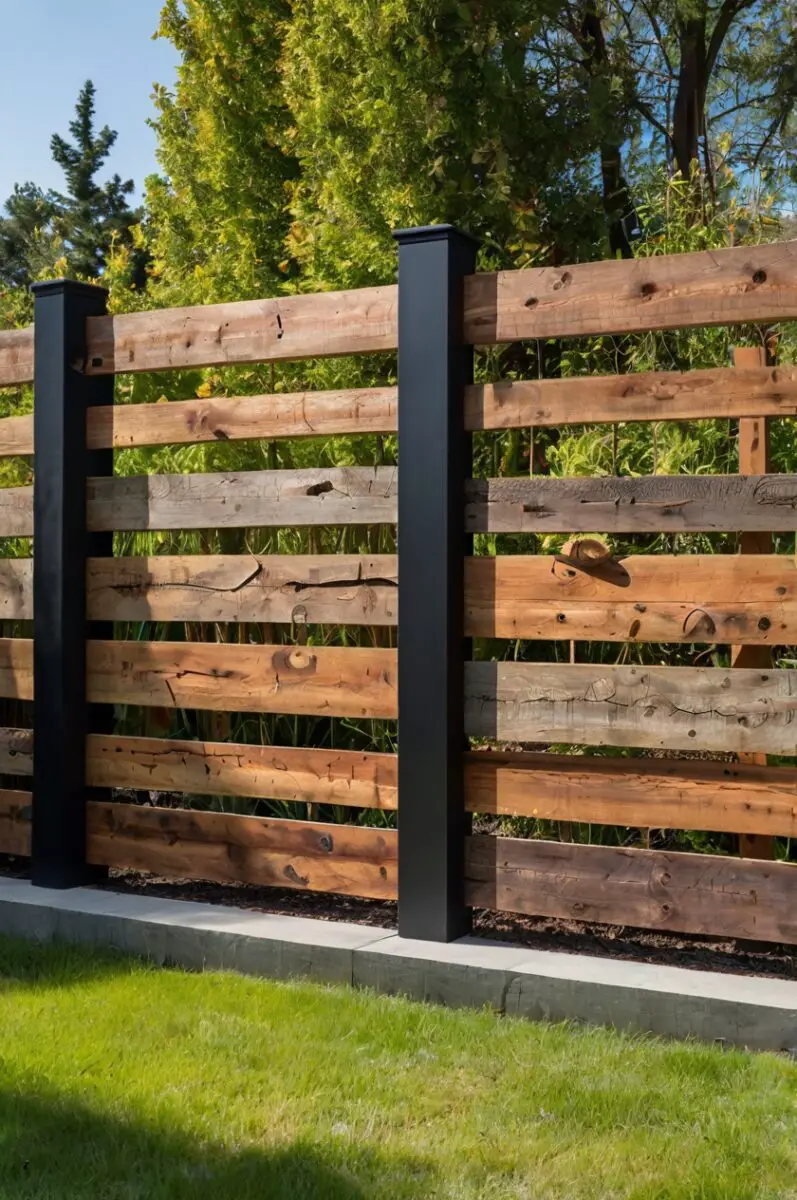
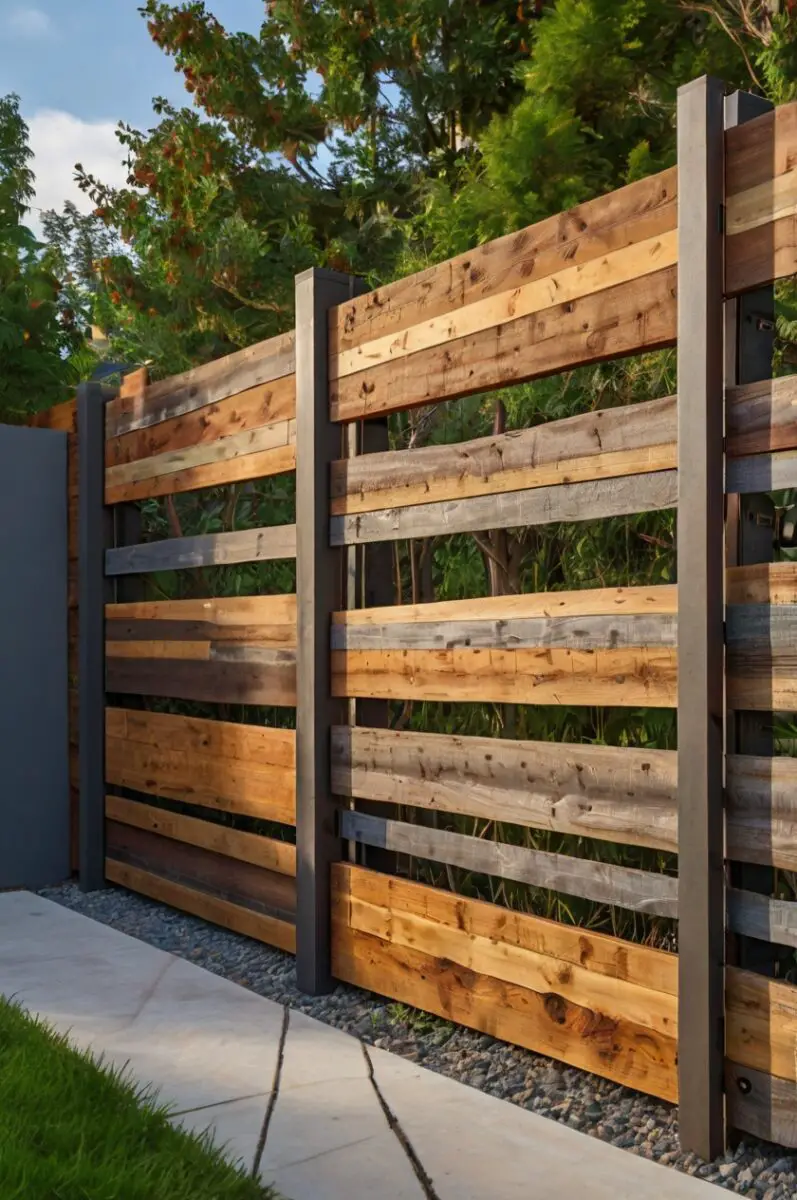
Reclaimed wood fences tell stories through their weathered surfaces and historical patina that new materials simply can’t replicate.
Each board carries the marks of its previous life – perhaps as barn siding, factory flooring, or even wine barrels repurposed into fence pickets.
You can create striking patterns by intentionally mixing woods with different weathering patterns and color variations.
These sustainable boundaries keep materials out of landfills while bringing character and history to your property lines.
The structural integrity of old-growth lumber used in many reclaimed pieces often surpasses the quality available in new materials today.
For authentic farm aesthetics, consider snake fencing constructed from reclaimed timbers – a zigzagging pattern that requires no post holes and creates instant rustic charm.
You’ll find that reclaimed wood often features hand-hewn textures, saw marks, or even original paint fragments that add to its visual interest.
Many homeowners incorporate found objects into these fences – vintage gates, antique hardware, or architectural salvage that becomes focal points within the design.
The weathered nature of reclaimed wood means less maintenance than new lumber, as it has already achieved the silver-gray patina that many desire.
Installation approaches vary widely, from traditional post-and-rail systems to more creative methods like vertical stacking or weaving patterns.
You can enhance the rustic appeal with complementary plantings – cottage garden flowers, heirloom vegetables, or heritage fruit trees that echo the timeless quality of the materials.
Cost considerations include sourcing (reclaimed lumber can be more expensive than new) balanced against reduced finishing requirements and unique aesthetic value.
These fences often become more beautiful with age as newer elements weather to match the patina of the original reclaimed pieces.
Shadow Box Fence Designs: Playing with Depth and Light
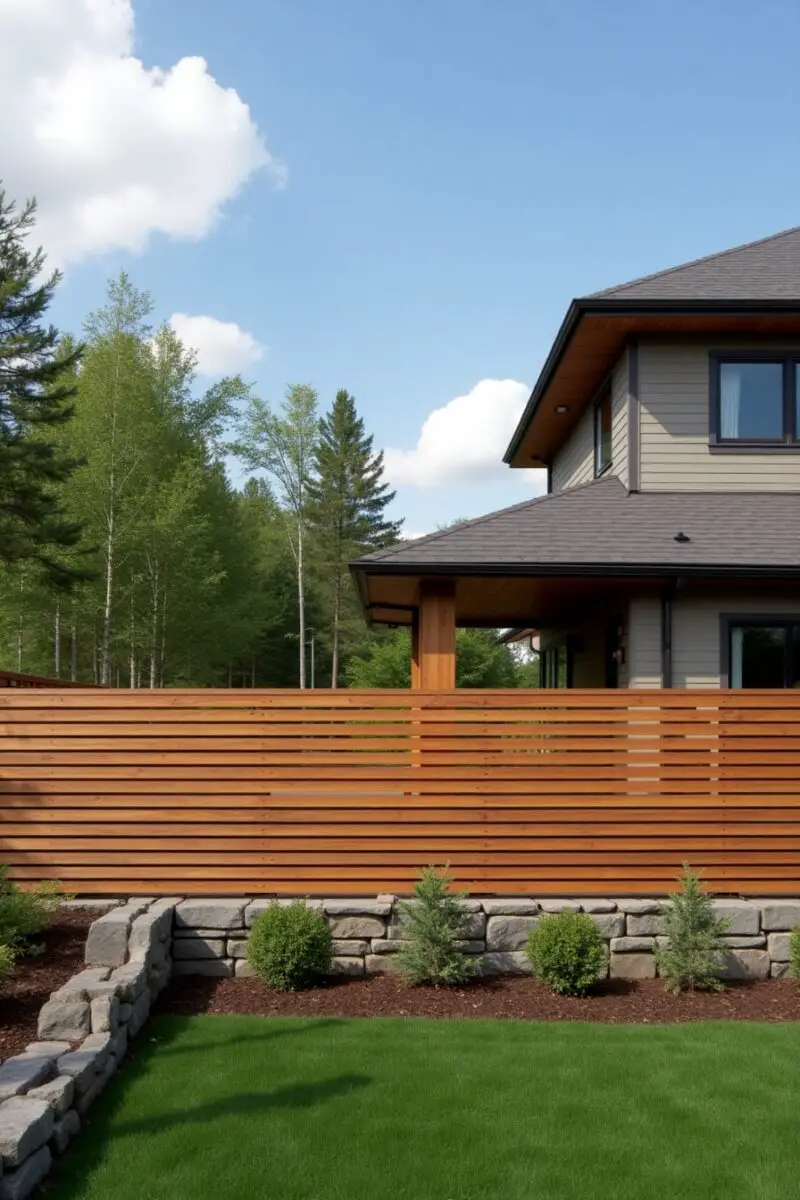
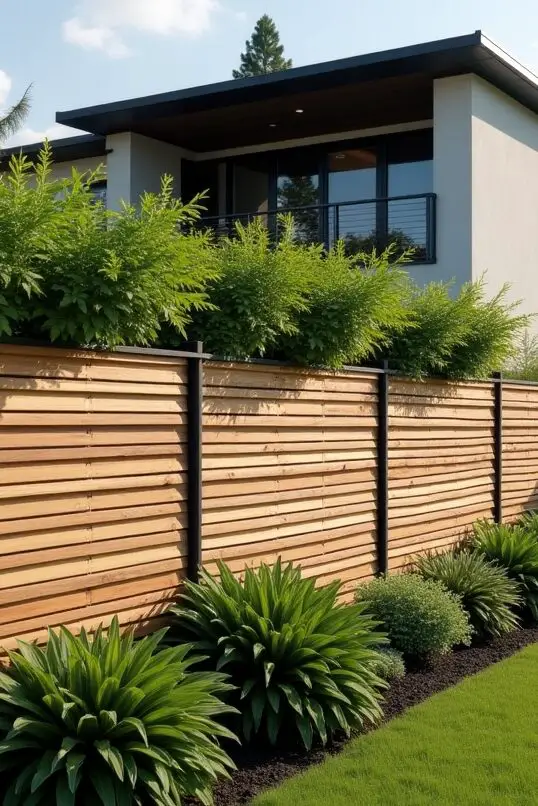
Shadow box fences elevate the standard privacy fence by staggering boards on alternate sides of the rails, creating depth and visual interest.
Unlike flat panel fences, these designs allow air to flow through while still blocking direct sightlines – the perfect compromise between openness and privacy.
You can customize the gap width between boards to control the degree of privacy and airflow that works for your specific situation.
The three-dimensional quality creates fascinating shadow patterns that change throughout the day as the sun’s position shifts.
Traditional shadow box designs feature vertical boards, but innovative homeowners are creating horizontal versions or even diagonal patterns for unique visual effects.
These fences look finished from both sides, making them perfect for boundary lines where aesthetics matter to you and your neighbors alike.
You’ll find that adding a decorative top – scalloped, diagonal, or arched – adds another layer of customization to your shadow box fence.
Many designs incorporate post caps with solar lighting or decorative metal elements that complement the dimensional quality of the fence itself.
The alternating board pattern provides natural resistance to wind damage, as gusts can pass between the boards rather than pushing against a solid surface.
Installation requires more materials than standard privacy fences but results in a sturdier structure with greater visual appeal.
You can play with board widths – alternating wide and narrow boards or creating rhythmic patterns that add subtle complexity to the design.
Color choices become particularly interesting with shadow box designs – painting alternate sides in complementary colors creates a changing appearance as you move around the property.
These fences cast intricate shadows on adjacent patios or garden beds, adding an ephemeral design element that changes with the seasons as the sun’s angle shifts.
✨Click to Get My 101 FREE Designer Room Ideas
Concrete and Wood Combinations: Strength Meets Warmth
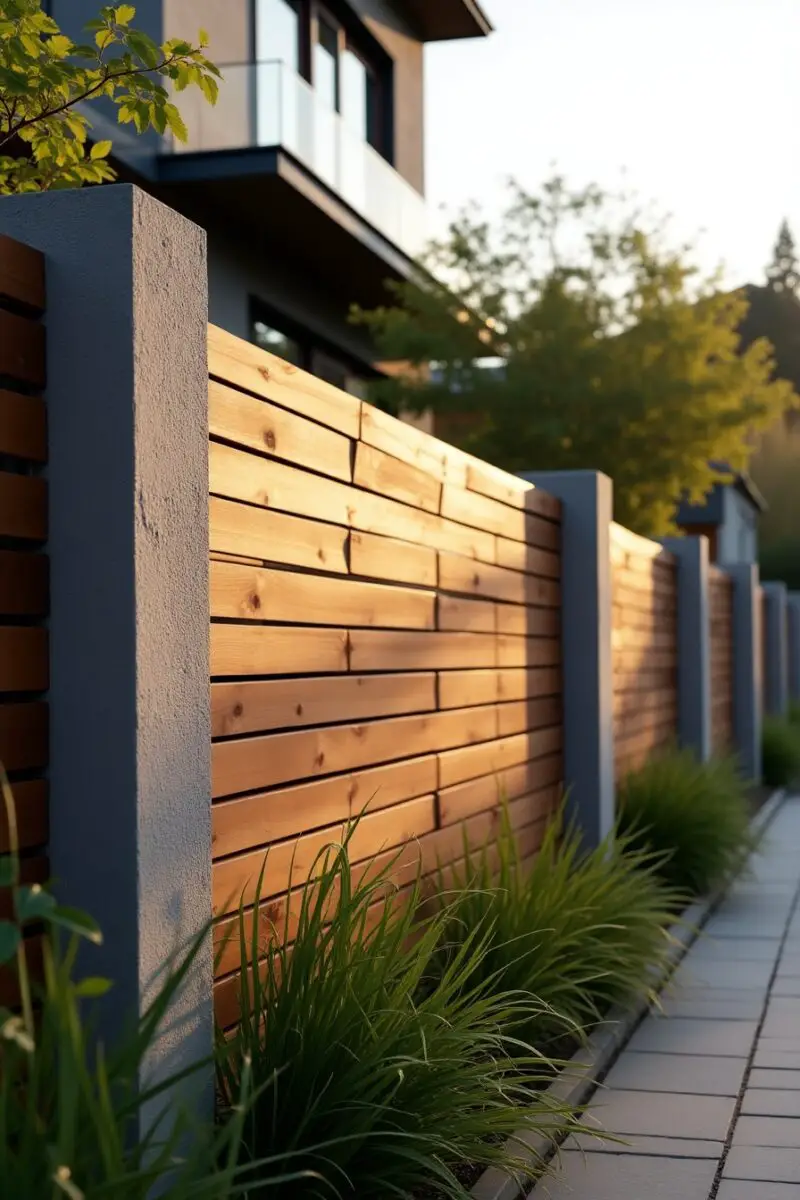
Concrete and wood fence combinations marry industrial strength with natural warmth in a surprisingly harmonious partnership.
These architectural boundaries typically feature concrete posts or panels with wooden infill sections, creating a rhythm of contrasting materials.
You can choose from various concrete finishes – smooth and polished for contemporary settings or textured and board-formed for more organic appearances.
The wood elements can be arranged vertically, horizontally, or in geometric patterns within the concrete framework.
These hybrid fences offer exceptional durability in the structural elements while allowing for easier replacement of wooden sections if needed over time.
Many designs incorporate lighting within concrete elements – recessed fixtures or fiber optic inlays that illuminate the boundaries after dark.
You’ll find that concrete provides opportunities for artistic expression through pigments, aggregates, or even embedded objects that personalize your fence.
The thermal mass of concrete sections can provide microclimate benefits, absorbing heat during the day and radiating it back during cool evenings.
Height variations work beautifully with these material combinations, with concrete elements often forming pillars or statement sections that rise above the wooden spans.
Installation requires specialized knowledge, particularly for the concrete components, which may involve pre-cast elements or on-site forming and pouring.
You can incorporate functional elements like built-in benches, planters, or water features within the concrete sections of these hybrid fences.
The contrast between the permanence of concrete and the natural aging of wood creates a dynamic boundary that evolves over time.
These substantial structures often become defining architectural elements of the property, creating a dialogue with the home’s design rather than merely marking its boundaries.
Architectural Corrugated Metal: Industrial Edge for Modern Spaces

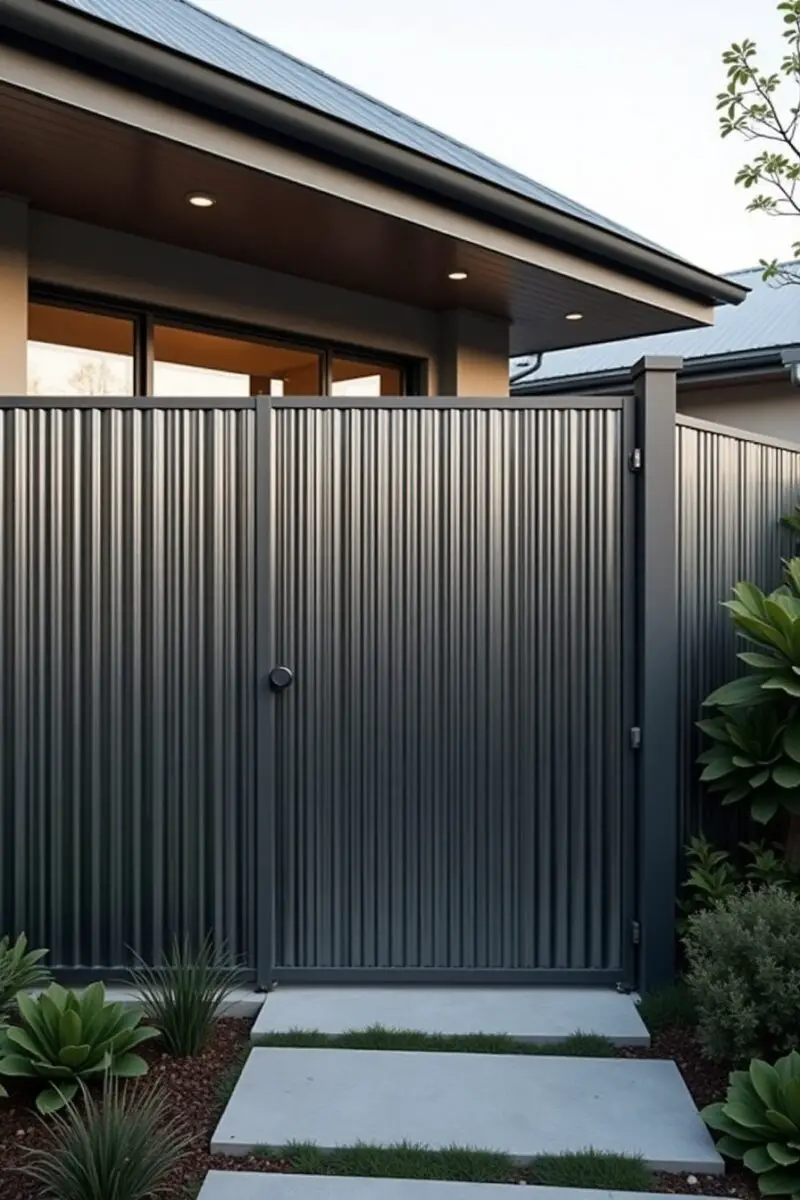
Corrugated metal fencing brings industrial chic to residential spaces with its distinctive wave pattern and contemporary edge.
These panels, once relegated to agricultural buildings and construction sites, now grace the most stylish modern homes with their unexpected sophistication.
You can choose from various metal options – traditional galvanized steel for a silver finish, Corten for a rusting patina, or powder-coated panels in bold colors.
The undulating surface of corrugated metal creates fascinating light play throughout the day, with shadows that ripple across the ridges and valleys.
These metal boundaries can be installed horizontally or vertically, with each orientation creating a distinctly different visual effect.
Many designs incorporate wood framing or posts that soften the industrial nature of the metal and tie it into the surrounding landscape.
You’ll find that these fences require minimal maintenance – no painting, staining, or replacing rotted boards – making them practical as well as stylish.
The reflective quality of metal panels can be harnessed to bounce light into shaded areas or to create dappled light patterns on adjacent surfaces.
Sound properties differ significantly from wooden fences, with metal creating interesting acoustic effects that can either amplify or dampen surrounding noises.
Installation is typically straightforward, with panels attached to a framework of posts and rails similar to traditional fencing systems.
You can mix corrugated panels with perforated metal sections or clear acrylic inserts for varied privacy levels within the same fence line.
The industrial aesthetic pairs beautifully with architectural plantings – ornamental grasses, succulents, or structural evergreens that complement rather than soften the modern edge.
These metal boundaries often become more interesting with age as patina develops and the relationship between the built element and surrounding landscape matures.

